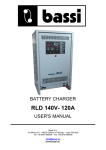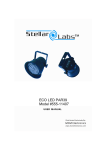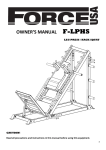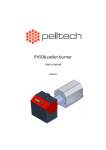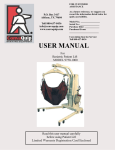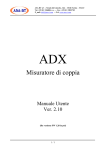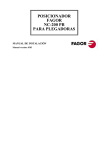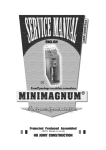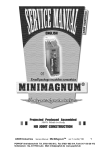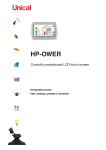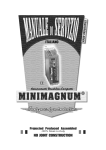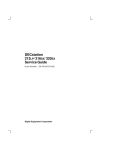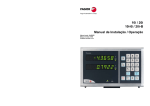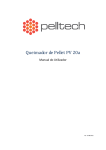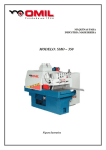Download Kasutusjuhendi kirjutamine
Transcript
PV700a / PV1000a pellet burners p 1/ 59 PV700a/PV1000a pellet burners User manual DK9401B1 DK9401B1 www.pelltech.eu PV700a / PV1000a pellet burners p 2/ 59 Contents Safety precautions ......................................................................................................................................... 4 Warnings ....................................................................................................................................................... 4 Notice ............................................................................................................................................................ 4 Set of components ........................................................................................................................................ 7 1 2 3 4 General description ............................................................................................................................... 8 1.1 Safety devices .............................................................................................................................. 12 1.2 Pellets .......................................................................................................................................... 13 Installation ........................................................................................................................................... 13 2.1 Prerequisites to boiler and boiler room ...................................................................................... 13 2.2 Burner installation ....................................................................................................................... 15 2.3 Water sprinkler ............................................................................................................................ 24 2.4 External auger ............................................................................................................................. 24 2.5 Pellet storage............................................................................................................................... 25 2.6 Electrical connections .................................................................................................................. 25 2.7 Initial start-up .............................................................................................................................. 27 Optional components .......................................................................................................................... 27 3.1 GSM modem ................................................................................................................................ 27 3.2 Error output ................................................................................................................................. 28 3.3 Flue gas fan .................................................................................................................................. 29 3.4 Oxygen amount sensor................................................................................................................ 30 3.5 Ash removal system .................................................................................................................... 31 3.6 External boiler temperature sensor ............................................................................................ 31 Operation and service ......................................................................................................................... 32 4.1 User interface .............................................................................................................................. 32 4.2 Starting and stopping .................................................................................................................. 33 4.3 Fuel refilling ................................................................................................................................. 33 4.4 Statuses and parameters............................................................................................................. 33 4.5 Output power levels .................................................................................................................... 40 4.6 Main menu and settings .............................................................................................................. 40 DK9401B1 www.pelltech.eu PV700a / PV1000a pellet burners 4.7 p 3/ 59 Regular maintenance .................................................................................................................. 43 5 Problems and solutions ....................................................................................................................... 43 6 Burner status change logic .................................................................................................................. 45 7 Annex 1 Electrical diagrams ................................................................................................................ 47 8 Annex 2 – Controller board ................................................................................................................. 50 9 Annex 3 Control unit ........................................................................................................................... 53 10 Annex 4 Table of parameters .......................................................................................................... 55 11 Annex 5 Table of languages ............................................................................................................. 57 Warranty ..................................................................................................................................................... 58 DK9401B1 www.pelltech.eu PV700a / PV1000a pellet burners p 4/ 59 Safety precautions Do not start the burner before it is connected to the boiler and the boiler is connected to the chimney. It is recommended to wear a respirator while handling pellets. The boiler room where the burner is installed must fulfil all rules and recommendations given by authorities. All electrical connections must be done by trained professionals. No flammable materials must be stored near the burner. Warnings Changing the construction of the burner without written permission from the manufacturer is forbidden. Use only spare parts provided or approved by the manufacturer in order to avoid any damage to the burner and dangers resulting from it. Welding is allowed only after disconnecting the burner from electric supply. The circuit board must be removed from the burner. Do not open any boiler door while the burner is in operation. Notice Manufacturer of burners has right to make changes in construction of burner and its firmware. Burner corresponds to following directives and standards: Directive 2004/108/EC Directive 2006/95/EC Directive 2001/95/EC Directive 2006/42/EC EN 15270 2008 EN 230 2005 EN 60370-2-5 2002 DK9401B1 www.pelltech.eu PV700a / PV1000a pellet burners Pellet burner PV 700a p 5/ 59 No Year of production 2014 Electrical supply 230V Max heat input 20kW Emission class 5 Noice emission 52dB Power consumption at stand-by 7W Manufacturer: Pelltech OÜ, Sära tee 3, Peetri, Estonia Pellet burner PV 1000a No Year of production 2014 Electrical supply 230V Max heat input 1000kw WW Emission class 5 Noice emission 52dB Power consumption at stand-by 7W Manufacturer: Pelltech OÜ, Sära tee 3, Peetri, Estonia DK9401B1 www.pelltech.eu PV700a / PV1000a pellet burners p 6/ 59 DK9401B1 www.pelltech.eu PV700a / PV1000a pellet burners p 7/ 59 Set of components 1 2 3 1. Burner with burning chamber 2. Bracket 2 pcs 3. Hose 76mm DK9401B1 www.pelltech.eu PV700a / PV1000a pellet burners p 8/ 59 1 General description PV700a and PV1000a are burners of wooden pellets (sawdust granules) that are intended to use in different boiler houses. Only wooden pellets with 6 or 8mm diameter can be used to run burners. You cannot use any other form of fuel but pellets to run the burner. Unique design of burners’ burning chambers allows to burn also industrial pellets. The construction of the burners allows them to be used with different boilers: liquid fuel, solid fuel and universal boilers. The burner is connected to the boiler by using a connection plate. The burner is equipped with a safety thermostat, a melting hose, temperature sensor, sprinkler system with pressure switch and auxiliary battery for protection against back-burning. Main technical data are given in Table 1 and Figure 1. Table 1 Technical data of burner Parameter L total length L1 housing length L2 burning chamber length ⌀D1feeder auger’s tube diameter Pellet inlet tube diameter H total height H1 burning chamber height W burner housing width W1 burning chamber width Required chimney diameter Mass net/bruto Max amount of flue gases Max fuel consumption Maximum/nominal power Minimum power Hold flame power Noise level Emission class EN 15279 Operating temperature Supply voltage El power at ignition El power, average El power at standby Unit mm mm mm mm mm mm mm mm mm mm kg M3/h kg/h kW kW kW dB Co VAC W W W PV700a 1190 592 590 80 76 598 451 606 528 300 150/185 1800 150 700 200 40 58 5 -10…40 3x380 1100 370 20 PV1000a 1306 624 682 80 76 621 545 706 614 350 230/280 2500 213 1000 250 60 58 5 -10…40 3x380 2100 480 20 Main components of the burner and their locations are depicted in Figure 2 and described in Table 2 . DK9401B1 www.pelltech.eu PV700a / PV1000a pellet burners p 9/ 59 Figure 1 Main measurements of PV1000 burner DK9401B1 www.pelltech.eu PV700a / PV1000a pellet burners p 10/ 59 2 1 3 12 4 5 6 10 7 8 9 11 13 14 15 16 15 17 5 18 5 20 7 19 21 Figure 2 Main components DK9401B1 www.pelltech.eu PV700a / PV1000a pellet burners p 11/ 59 Table 2 List of main components No 1 2 Name Burning chamber Burner body 3 4 User interface Control unit 5 Water sprinkler 6 Grate cleaning motor 7 Igniter 8 Brick temperature sensor The part of the burner that is outside the boiler and where burner’s control and pellets supply takes place. Control board with screen, navigation buttons and indication lights. Electrical- and control panel what contains inverters, fuses, relays, main controller board and other control devices Sprinkler system will spray water to extinguish the fire in feeder’s tube in case of back burning. The sprinkler system is activated only when the temperature of feeder auger rises dangerously high. Linear motor moves the grates in burning chamber and pushes ash out from burning chamber. This cleaning cycle is made periodically. The interval between cleaning cycles can be controlled by PAR48. In each cleaning cycle, the linear motor pulls grates back then pushes the grates completely out. The linear motor has 75mm stroke and end switches for stop. Linear motor current limit can be set by PAR47. Linear motor is protected by fuse F10 what is installed on the controller board (board version BBB v2.1). Igniter´s purpose is to ignite loaded fuel making the burning process start. Igniter is installed on the burner together with igniter holding pipe. PV700 has 2 igniters and PV1000 4 igniters. A sensor to adjust bricks’ heat up speed according to temperature rise. Brick temperature rise speed control helps to reduce thermal stress of bricks and prolong their lifetime. 9 Cleaning hatch Hatch below burning chamber to ease the removal of ash under the grates. 10 Grates support frame Holds moving and stationary grates in correct position. 11 Grates 12 Fire bricks 13 Flame sensor Burning of pellets takes place on the cast iron grates. Air needed for burning is blown to burning chamber via holes with different size. Burner has moving and fixated grates. Moving grates move periodically to clean the burning chamber. Burning chamber is surrounded with heat resistant from up and sides. Bricks are necessary for proper airflow and combustion. Photocell´s purpose is to recognize flame in the burning chamber. 14 Level sensor 15 Combustion air fans Left – primary Right – Description The part of the burner that is inside the boiler and where pellets are burnt. Optical fuel level sensors recognize the fuel level in the vertical pipe. Fuel is recognized when pellets pass the optical beam between sensors. Primary fan blows main burning air needed for ignition, burning and gasification of the fuel. Secondary fan blows air through burning chamber back-wall and holds burning DK9401B1 www.pelltech.eu PV700a / PV1000a pellet burners secondary fan 16 Controller board 17 GSM modem (optional) 18 Feeder auger motors 19 Battery 20 Internal feeder screw 21 Pressure sensor connection 1.1 p 12/ 59 quality and optimal flue gas content. To control the burning procedure oxygen sensor (optional) for fan’s speed regulation is used. Both fans rotation speed is measured by sensor, installed near the impeller axle. The sensor is reading magnetic field changes caused by magnet installed on the impeller axle. Controller board controls the burner´s burning process, by calculating fuel amount also feeder and auger work during burning process. Depending on the input signals from the sensors, controller makes necessary changes to the output states to maximize burning efficiency. Controller has a single control board. A GSM modem enables burner to send SMS messages with various information of burner´s operating states (errors). GSM modem is located on control unit. Internal feeders are used to deliver correct amount of fuel into burning chamber. Delivered fuel amount is regulated by periodical work of feeder gear motors. 24V DC motors are supplied from backup battery to empty feeder tubes in case of power failure. When there is no power from the main power supply then the burner is operating on battery power. PV1000 uses two 12V 3,4 Ah batteries. Because the battery is a safety element, the burner checks batteries condition and does not start the next working cycle if the batteries voltage is too low. Hollow spiral connected to feeder motor to transport pellets into burning chamber. Screw is not tightened to motor, but has small slack. It lowers the mechanical stress and expands gear motor lifetime. Metal tube to connect pressure sensor input. Pressure sensor measures draught in burning chamber and enables the controller to regulate flue gas fan speed. Safety devices The back-burning is the biggest danger risk at burners working procedure. Back-burning appears when usual pressure or draught conditions have changed in boiler’s combustion chamber. There are several reasons for such changes. In order to secure operational and fire safety the PV700a/PV1000a burners are equipped with following safety devices: Back up batteries. Enable to finish safely burning procedure in normal conditions or during unexpected black out in mains supply. Melting hose. The external auger is connected to the burner with a special hose (∅ 76mm), which is made from easily melting polyurethane material that interrupts when back-burning takes place. Such measurement avoids entrance of the flame from burner into external auger and pellets container. Thermostatic sprinkler valve. Enables to extinguish the fire in feeder’s augers tube by spraying water into it, when burner is overheated due to possible back-burning or any other reason. DK9401B1 www.pelltech.eu PV700a / PV1000a pellet burners p 13/ 59 Fire safety water pressure control switch (pressostat). Enables to keep necessary water pressure in water reservoir and to ensure with that successful extinguishing procedure when needed. Pressostat switch allows starting the burner only if water supply is present and pressure exists. 1.2 Pellets Wooden pellets or saw dust granules are concentrated and homogenized wooden fuel. Pellets are pressed with high temperature. No extra materials are added, pellets are held together by a natural ingredient found in wood – lignin. Pellets are neutral, renewable fuel. Its burning doesn’t spoil CO2 balance in the atmosphere. Not only premium but also the industrial pellets can be used in PV700/1000a. Pellets must be stored in a dry and ventilated room. Table 3 provides an overview of pellet properties and threshold values. Table 3 Pellets’ overview Raw material Premium pellets Sawdust, cutter shavings, stem wood Calorific value Volume weight Volume of 1 ton pellets Diameter Length Moisture content Ash content To replace 1000 l light oil 4700-5100 kWh/ton ca 650-670 kg/m3 1.5-1.6 m3 6-10 mm 3-5 x diameter 8-10 % ca 0,5% ca 2 tons or 3 m3 Industrial pellets Forest, plantation and other virgin wood, chemically untreated wood residues ca 4700 kWh/ton >675 kg/ m3 ca 1.5 m3 6-12 mm ca 4mm ca 5 % ca 2% ca 2 tons or 3 m3 2 Installation 2.1 Prerequisites to boiler and boiler room In order to install the burner, the boiler must meet to the following requirements: It is recommended to use three pass boilers. The construction of the boiler must make it possible to open the door of the boiler with the burner connected and removing ash from the furnace. If the door of the boiler is too narrow for opening it with the burner, then extra hinges must be mounted. If there is not sufficient (less than 5Pa) negative pressure in the furnace, a flue gas fan should be installed to improve the movement of the exhaust gases. The boiler must be installed into boiler’s room in a way that there is enough space for cleaning the burner, the boiler, the smoke pipe and removing the ash. The burning chamber must not touch the bottom of the boilers furnace (min 10 cm distance needed). DK9401B1 www.pelltech.eu PV700a / PV1000a pellet burners p 14/ 59 The boiler room where the burner is installed must fulfill all rules and recommendations given by local authorities. 2 Boiler room must provide constant air supply of 1500 m³ per hour (ca. 1600 cm air inlet opening). In order to mount the burner to the boiler door, it must have mounting holes. See Figure 3 . Notice! If the burner is installed to the boiler, the door’s or the installation flange´s thickness should be 8-14mm. Dimension ⌀D hole for burning chamber neck ⌀D1 flange bolt ring diameter ⌀D2 bolt holes Bolt hole offset angle Angle between bolt holes Unit mm mm mm deg deg Value 400 490 6 x 13 30 60 Figure 3 Boiler door mounting opening Cutting contour of hole to be cut to boilers door in order to install PV1000 burner. Figure 4 Contour of cutting DK9401B1 www.pelltech.eu PV700a / PV1000a pellet burners p 15/ 59 Boiler’s firebox depth L must be at least 2,5 times longer than the length of burner’s burning chamber. Thus minimal length of the firebox L for PV700 has to be 1500 mm and for PV1000 1800mm. The height of firebox must leave at least 100 mm space (H1) for ash below burning chamber. Minimum dimensions: L1 ≥700mm; H ≥650mm. See Figure 5. Figure 5 Firebox depth Pellet burners need regular cleaning and therefore boiler construction must allow easy opening of boiler’s door without removing the burner. The minimum size of opening in boiler’s door depends on the position of door hinges. Figure 6 below illustrates the situation. Point C is the critical point. In order to keep door width minimum and boiler’s door opening small, a double hinge solution can be used. As double hinges add another degree of moving-freedom, door must be fastened on both sides. Slide-out doors with guide rails is also an option. Figure 6 Burner has to reach off from boiler 2.2 Double hinges Burner installation Burners are delivered to customer in fully put together. Before mounting the burner to boiler it has to be disassembled i.e. bricks have to be removed and burning chamber separated from burner and air box. Mount the burning chamber on the inner side of the boiler door. Figure 7 DK9401B1 www.pelltech.eu PV700a / PV1000a pellet burners p 16/ 59 Use 6 M12x60mm bolts, spacers and distance nuts respective to the bolts. Figure 8 Install the insulation rope between the burning chamber and the boiler door. The rope must be installed near the outer perimeter of the burning chambers back wall. Figure 9 DK9401B1 www.pelltech.eu PV700a / PV1000a pellet burners p 17/ 59 Grate holders installation Install the burning chambers bottom panel (15x15mm insulation rope must be inserted to the slot in the panel) with 6 M8x16mm bolts. Install the burning chambers front panel (heat shield), use M8x16mm bolts. Figure 10 Connect the static grate holders with the side stone holders separately and install them together into the burning chamber as a frame. Fix them with M8x16mm bolts to the burning chamber. Figure 11 DK9401B1 www.pelltech.eu PV700a / PV1000a pellet burners p 18/ 59 Connect the moving grate holders with M6x12mm bolts. Figure 12 Install the burning chamber’s front brick holders, use M8x16mm bolts. Figure 13 DK9401B1 www.pelltech.eu PV700a / PV1000a pellet burners p 19/ 59 Release the igniter tube screws and while inside the holders pull the tubes out about half of the total length. Figure 14 Move the air separator to its correct position (according to the boiler door thickness) and fix it with screws. Figure 15 DK9401B1 www.pelltech.eu PV700a / PV1000a pellet burners p 20/ 59 Install the ceramic sealing strips on the boiler door. Fix them temporarily in position with any ordinary cellophane tape (scotch). Cut away the excessive sealing on the perimeter of the air chamber. Figure 16 Mount the burner’s housing on the boiler door, using 4 M12x70mm bolts and respective washers. Figure 17 Push the igniter tubes through the burning chambers back wall and fix them in position with M4 screws. Figure 18 DK9401B1 www.pelltech.eu PV700a / PV1000a pellet burners p 21/ 59 Connect the linear motor with the moving grate holder. Use 27x2,5mm pipe (length 240mm), M8x45mm bolt for the burning chamber side and a M6x25 socket set screw (DIN914 45H) on the linear motor side. Figure 19 Push the stone temperature sensor through the hole in the burner body and the pipe on the burning chambers back wall, isolate it from the air flow (accessible from the burning chamber side) with ceramic sealing to prevent cold air from tampering with the measurements. Figure 20 DK9401B1 www.pelltech.eu PV700a / PV1000a pellet burners p 22/ 59 Install the 2 lower position grates . Install the 8 middle position grates with 5mm holes . Install the 8 higher position grates with 7mm holes. Figure 21 Install the ceramic seal on the back wall of the burning chamber. Install the back wall stones on the burning chambers back wall. Caution! Be careful not to damage the temperature sensor! Push the stone temperature sensor into the opening in the back wall stone. Figure 22 DK9401B1 www.pelltech.eu PV700a / PV1000a pellet burners p 23/ 59 Install the upper grate holder and 2 upper grates. Fix the holder with M10 wing nuts. Figure 23 Install the 6 side bricks. Install the 6 arc-stones. Notice! The arc-stones are numbered; they must be installed as pairs! Figure 24 DK9401B1 www.pelltech.eu PV700a / PV1000a pellet burners 2.3 p 24/ 59 Water sprinkler Principal chart of water sprinkler installation is depicted in Figure 25. Water sprinkler is main safety element against back-burning. It is strongly recommended to install sprinkler system. Pressure switch allows starting the burner only if water supply is present. If no water is available on installation site, reservoir can be filled manually. In this case, pressure switch is not connected to safety circuit as there is no pressure in water system. In case of back-burning, sprinklers will open and fire is extinguished in feeder tubes. Flow control valve limits the amount of water flowing into burner after the reservoir is emptied. The burning chamber must be cleaned from wet ash and pellets before turning the burner back on again. Figure 25 Water sprinkler installation 2.4 External auger The external auger transports pellets from the pellet container to the burner. The burner controls the work of the external auger. The auger is connected to the burner with a special hose (∅ 76mm), which is made from easily melting material- polyurethane that acts as a safety measure against back-burning. PV1000a pellet burner´s fuel consumption at full power is about 208-222 kg of pellets per hour ( 3,3-3,7 kg per minute ). External auger´s productivity for PV700/PC1000 must be at least 270kg of pellets per hour. The auger can be fixed to the storage or a ceiling depending on the conditions at the installation site. Critical requirements for external auger installation: The raising angle of the auger must not exceed 45° The end of the exit tube of the auger and the input of the burner must not be aligned. The recommended minimal horizontal distance is ca 20cm. The distance between the input of the burner and the exit tube of the auger must be at least 60cm vertically – recommended distance is 80-200cm. Hose between auger and burner must be tight, otherwise pellets will block the auger. Falling angle must me between 65° and 85°. All critical requirements for installation of external auger are depicted in Figure 26 . DK9401B1 www.pelltech.eu PV700a / PV1000a pellet burners p 25/ 59 20cm >65 max45 o >60cm o Figure 26 External auger installation 2.5 Pellet storage Pellets must be stored in a dry and ventilated room that is separated from the boiler room. A tailor made storage (silo) is recommended. All safety regulation must be taken into consideration according to the local laws. It is recommended to wear a respirator when handling pellets. Refilling must be carried out before the storage runs empty. 2.6 Electrical connections Following connections must be done by the electrical installer: 1-phase supply and boiler’s thermostat to socket X11 . See Figure 27. 3-phase supply to socket X12 External auger to socket X14 Names and marking of sockets is described on Table 4. Figure 27 Connection of socket X11 DK9401B1 www.pelltech.eu PV700a / PV1000a pellet burners p 26/ 59 Table 4 PV1000a connectors No. Name X11 Control voltage, boiler’s thermostat X12 Main power supply X13 Safety circuit X14 External auger 1 X15 External auger 2 X16 Primary fan X17 Igniters X21 Flue gas fan X20 Flue gas inverter X22 Modbus X23 Pt100/4..20mA sensors ( O2 and boiler water) X24 Level sensors (silo1 and silo2) X25 Ash auger and scraper X26 Secondary fan X27 Igniters Voltage, amps 230VAC, 3A 3x380VAC 20A 230V 3x380V 0,55kW 1,6A 3x380V 0,55kW 1,6A 3x230V 0,18kW/0,37kW (PV700/PV1000) 2x500W 2x2,2A (PV1000) 3x230V max 1,5kW 0...10V, 24V DC 24V DC 24V DC 24V DC 230V 90W 3x230V 0,18kW/0,37kW (PV700/PV1000) 2x500W 2,2A (PV700, PV1000) Figure 28 Connectors’ markings DK9401B1 www.pelltech.eu PV700a / PV1000a pellet burners 2.7 p 27/ 59 Initial start-up Prior to the initial start-up of the burner make sure that: The burner is connected to the boiler. The boiler thermostat is installed and is functioning properly. The feeding auger of the burner is installed and connected to the burner. The smoke duct is connected to the chimney, the dampers for smoke gases are open and there is sufficient draught. When the burner is operating, the negative pressure inside the furnace must stay between 5-20 Pa. Sprinkler system is connected and pressure switch connected to safety circuit (chapter 2.3). Phase (L) and neutral (N) wires in power cable are connected properly. 3 Optional components 3.1 GSM modem PV700a and PV1000a burners are ready to send burner’s error SMS messages up to 5 phone numbers. When error occurs the modem will send list with history of errors and statuses before error. If list is very long then so much information what has a room in message will be sent. Average length of one message is 8 statuses or errors. In order to send messages EP007 modem has to be connected to burners control board’s connector X2. See Figure below. RS232 modem adapter cable has to be connected between modem’s connector MOD1 and connector MOD1 what is located lower part of control board. Figure 29 Modem connection Before inserting the SIM card to burner the following actions have to be done: 1. SIM card must by activated by the mobile operator. 2. PIN code request has to be switched out. 3. Check by using mobile phone that it is possible to send SMS with this SIM card. 4. In SIM card´s phonebook must be only the numbers, where to the messages from the burner will be sent. DK9401B1 www.pelltech.eu PV700a / PV1000a pellet burners p 28/ 59 To insert the SIM card, the modem has to be disconnected from supply mains. To insert the card push it into a slot as long as its spring clicks and fixes the card. See Figure 30. To remove card push it in as long as spring clicks and pushes it out. In order to activate SMS sending, in burners menu PAR52 has to be changed. Value shows for how many numbers the message will be sent. “0” means no messages to be sent. “2” means that messages will be sent to 2 first recipients in SIM card in order of phone number insertion. Figure 30 SIM card insertion Modem has two indicators. Green one shows that modem is turned on. Red one shows modem status. Modem’s statuses are described in Table 5. Table 5 Modem statuses Red LED indicator Permanently on Fast interrupt sequence (period 0,5 s Ton 1s) Slow interrupt sequence (period 0,3s Ton 3 sec) Permanently off 3.2 Modem status Sending message (on-going call) Net search/Not registered/ Turning off Registered full service Device is turned off Error output PV700/PV1000 burner has built in error output what gives 230 VAC tension (NO) to 7-pole socket’s S3 connector or interrupts it (NC) if burner delivers any error message from elven (FLAME ERROR, BATTERY EMPTY, IGN.ERROR etc). Device (motor, modem etc) up to 5A@230VAC can be connected to circuit. PAR50 defines weather error output is closed or open during error appearance. Depending on NO or NC selection values in PAR50 have to be changed. PAR50 value 1 2 3 4 5 Description Normaly open circuit (NO). Switches on when error appears. Normaly closed circuit (NC). Switches off when error appears. SWITCHED ON in IGNITING, HEAT UP, BURNING and HOLD FLAME statuses. Not in use. Not in use. DK9401B1 www.pelltech.eu PV700a / PV1000a pellet burners 3.3 p 29/ 59 Flue gas fan The burner needs stable under-pressure in burning chamber for its correct operation. Simplest way to assure this is to use the flue gas fan between boiler and chimney. With flue gas fan the burner can control and hold constant under-pressure. In order to control flue gas the PAR60 value has to be set to”2” ON. Selected flue gas fan must provide transmission of the maximum flue gas amount and exceed the pressure provided by boiler, ash cyclone and chimney. The flue gas capacity for burned pellets can be calculated by simplified formula. V – Capacity range in m³/h P – Burner max power in kW Tfg – Flue gas absolute temperature in K Troom - Room absolute temperature in K λ (lambda) – Excess air ratio PV burners are designed to work at lambda values 1.2...1,5 - for calculations choose value of 1,5. Flue gas fan must be installed between boiler and chimney. If ash cyclone is used then flue gas fan must be installed between ash cyclone and chimney to avoid overpressure in cyclone and smoke leakage. Burner setup Depending on burner’s configuration (weather inverter included or not) the electrical connections may be different. In case the frequency inverter has already been installed in factory to the burner, the flue gas fan can be directly connected to the burner through connector Y8. Fan must be connected to burner with 3-wire cable (3x1,5mm²). Internal inverter output is 3 x 230V. If flue gas fan motor is a three phase motor (3 x 230/380V) then it has to be connected as triangle. In case the burner has no inverter, the external inverter for flue gas fan can be used. Inverter must be selected according to fan motor’s parameters and available power supply. The inverter must be switched to sink logic (negative common). To connect the external inverter with burner there is connector Y7 with 3 output signals: • T1 - burner DC common (ground), must be connected with external inverter input common. • S3 – inverters “run” command, must be connected with F (forward) pin on inverter input. Burner will connect this pin to ground when fan must run. • B4 – 0… 10V output for fan speed, must be connected with inverter analogue input. Inverter setup Inverter parameters are set up at factory for automatic control. To test flue gas fan manually: 1. Press Easy button on inverter 2. Press Dial button and change settings : CN0d – “0” FN0D – “0” F174 – “0” DK9401B1 www.pelltech.eu PV700a / PV1000a pellet burners 3.4 p 30/ 59 Oxygen amount sensor Oxygen amount sensor (oxygen sensor) allows the burner to keep pre-set oxygen level in flue gas, what increases the efficiency of the burning process. The oxygen sensor is connected to socket X23 as shown on Figure 31 . If the sensor requires heater connection, it can be connected between T6 and B5. X23 PT100 T8 -mA/PT100 T7 +27.2V T6 GND -mA O2 +mA Heater B5 JP1 JP2 3 2 1 Figure 31 Oxygen sensor connector Following instruction is applicable for firmware version 2.08. In order to implement oxygen sensor two parameters PAR66 and PAR67 in parameters menu have to be set-up: Table 6 PAR66 and PAR67 set-up Parameter No Description Unit Name PAR66 OXYGEN TYPE PAR67 OXYGEN SET Value Def 0 – no sensor 1 – 4…20mA = 0…25% oxygen 2 – 4…20mA = 0…20% oxygen Oxygen level set-point in flue gas Min Max - 0 0 2 - 6 4 12 For oxygen amount sensor EP0006 in parameters menu, the PAR66 value has to be set to “1”. Some third party oxygen amount sensors use 4…20mA output for 0…20% oxygen. In this case, value “2” must be selected. If PAR66 is set to “0” (no sensor), secondary fan is driven by air table set in PAR31 – PAR36. Secondary fan also switches back to air table if oxygen level reading is below 3% or over 19%. Oxygen sensor is located inside the burning chamber. Oxygen level control starts 5min after burner enters into BURNING status. It can take about 10min for oxygen level to stabilize. Oxygen level can be seen in INFO-menu next to pressure reading. The value on the screen must be divided by 10 to get the real value. For example “O2=113” means oxygen level value 11.3%. DK9401B1 www.pelltech.eu PV700a / PV1000a pellet burners 3.5 p 31/ 59 Ash removal system The burner can control external ash removal auger and scraper motors via X25 connector. During burner’s cleaning cycle the X25 connector is powered and ash removal and scraper motors can be switched on via X25 connector’s L1 and L2. 3.6 External boiler temperature sensor External temperature sensor enables the burner to maintain constant boiler’s water temperature. For that external temperature sensor has to be installed to relevant place on boiler, existing burner’s temperature sensor to be disconnected from TMP1 connector on controller’s board and external sensor to be connected to connector TMP1. In parameters menu PAR53 value has to be chosen “2”. When temperature holding status is activated, then burner will change its capacity according to water temperature and speed of temperature changing. Burner starts to change its capacity when BURNING status has lasted longer than set in PAR15. Capacity is changed after time set in PAR17. Following actions must be done to enable temperature hold mode (THM): 1. Mount external temperature sensor to boiler according to boiler manufacturer instructions. 2. Connect the sensor to TMP1 connector on controller board. 3. Choose PAR53 value (sensor type) according to Table 7. 4. Set requested temperature – PAR54. It should be lower than boiler thermostat temperature. Otherwise the boiler thermostat would force the burner to turn off before reaching PAR54 value. 5. Optionally PAR55 - the hysteresis of requested temperature can be changed. THM activates if PAR53 value is larger than “1” and BURNING status has lasted longer than set in PAR15 typically 30min). The burner will change its output power according to current measured temperature and the rate of temperature change. New power level is selected after every time interval specified in PAR17. Table 7 PAR53 values PAR53 0 1 2 Sensor type No sensor 0..2.5V Temp min 0ºC (0.5V) Temp max 125ºC (1.75V) 0..2.5V 0ºC (0.5V) 125ºC (1.75V) Function Burner’s actual internal over temperature sensor. Overheat value to be set PAR43. Boiler temperature control with external sensor. After activating THM, following row is displayed on INFO-screen e.g.: „T=22.3/70±5↓200o“. It means following: 22.3 – Actual measured temperature. 70 – Set point temperature (PAR54). ±5 – Set- point hysteresis (PAR55). ↓ - Shows weather actual temperature is increasing or decreasing. 200o – Forecasted temperature in 10min. DK9401B1 www.pelltech.eu PV700a / PV1000a pellet burners p 32/ 59 4 Operation and service 4.1 User interface The burner is controlled via user interface on the front panel. 3 row LCD screen (1) displays main menu, submenus, event log and statuses. Yellow light (2) shows the existence of flame in burning chamber. If it blinks, the burner is out of normal operation. Green light (3) indicates existence of pellets in the burner. Burner on/off switch (4) can be used any time to turn the burner safely on or off. Operation light (5) indicates weather the boiler thermostat is turned on or off. Fault light (6) is connected to safety circle and indicates its being in order. “Up” and “down” (Ʌ V) buttons enable to move in menus. “Left” and “right” (> <) buttons enable to control the burner and change parameters. To get back to main menu (<) button is used. It acts like an escape button. “Right” (> ) button enables to change values in selected parameter. To enter to setup menu or to confirm changes of values OK button is used. OK and < buttons have different functions depending on context. See Table 8. Figure 32 User interface 1 – 4x20 character display 2 – Yellow LED, indicates if flame is detected in burning chamber 3 – Green LED, indicates if pellets are present in internal feeder 4 – Burner on/off switch with power indication light. 5 – Burner operation light, showing if the boiler thermostat sends a signal to the burner. 6 – Fault light of safety circle 7 - GSM modem antenna Table 8 User interface controls Button OK OK < Push time <3s >3s Action To enter to setup menu To confirm settings (in parameter edit mode) To reset error, resume normal operation To reset counter (only in counter screen in INFO menu) To move back in menu by one level DK9401B1 www.pelltech.eu PV700a / PV1000a pellet burners OK + < 4.2 >3s p 33/ 59 To cancel change (in parameter edit mode) To restart burner Starting and stopping To turn on the burner: Turn on boiler main switch. If burner displays STOPPED, then go to main menu and BURNER set from ON to OFF. WAITING is displayed. Turn boiler’s thermostat to requested temperature. Burner goes to TESTING state and then to LOADING state. If this is the first run, external auger needs to fill up with pellets. It can take as long as 20minutes, because external auger has to be filled with pellets. To stop the burner: set in main menu BURNER from ON to OFF. Now the burner will burn all pellets in burning chamber and turn safely to STOPPED mode. STATUS menu displays the changes: BURNING SLOW DOWN END BURN END BLOW WAITING STOPPED The stopping procedure may take up to 30 minutes. Attention! If necessary the boiler’s thermostat can be turned on/off from burner red switch with power indication light Figure 32. Caution! Do not turn off mains power to terminate burning process. Use the boilers thermostat for that. In order to complete burning procedure safely let the burner to burn all fuel in burning chamber. Never leave burner unattended when you had to stop boilers work turning boiler off from mains switch in any reason. 4.3 Fuel refilling Fuel container (silo) has to be refilled before its runs out. The fuel can be added any time to container (silo). If container runs out before refilling, refill it and restart the burner. The start-up takes now longer about 20 minutes, because external auger has to be filled with pellets like in initial start-up. Turn burner from BURNER menu ON. Vice versa the LEVEL ERROR will be displayed, because loading time is exceeded. 4.4 Statuses and parameters PV700a/PV1000a pellet burner operates in many different states, which are called “Statuses” and which are displayed in user interface in STATUS menu (chapter 4.1). Burner changes its statuses based on input signals from sensors and user setup. The working statuses of the burner in typical order of succession are given in Table 9. The duration of all actions are in form mm:ss (’m’ in the middle) or hh:mm (’h’ in the middle). For example: ’IGNITING 01m25“means the burner ignition state lasted 1 minute and 25 second. DK9401B1 www.pelltech.eu PV700a / PV1000a pellet burners p 34/ 59 Table 9 Summary of burner statuses Status WAITING TESTING CLEANING LOADING IGNITING PRE-BURN HEAT UP BURNING HOLD FLAME END BURN END BLOW WAITING Short description Waiting when boiler’s thermostat switches on. Boiler’s thermostat is switched on, testing the battery, fans, feeder, level sensors and draught in progress. Ash removing from burning chamber. Loading pellets with external auger into burner and by feeder auger into burning chamber. Igniter is turned on, pellets are ignited. Flame is recognized, small amount of pellets is added by feeder auger. Burning chamber ceramic stones are heated up. Normal burning operation. Thermostat is switched off, small flame is held alive. Thermostat is switched off, feeder is burned up. Pellet coals in burning chamber are burnt, flame has disappeared. Burner waits when boiler’s thermostat switches on. At WAITING status, the burner waits when boiler’s thermostat switches. There is no time limit for WAITING status. Only feeder auger is working periodically at WAITING status and makes ½ rotations after every 2 minutes. With this feeder augers spiral cleans feeder’s tube from wastes. When boilers thermostat switches on, burner will go to TESTING. At TESTING status, burner‘s integrity and important device functioning are checked. List of tests is given in Table 10. Table 10 List of tests in TESTING status Test name Battery voltage PAR No - Feeder current PAR 46 Draught Primary fan Secondary fan PAR62 PAR4 PAR4 Value Unit Test conditions 22 V Battery loading is turned OFF and feeder is turned ON voltage must be greater than 24V. 3..6 A Feeder auger is turned ON – feeder current must be smaller than PAR 46. +10 Pa All fans are turned on. Draft must be under PAR 62. 38 rot Fan must rotate faster than 35rot = 38 (PAR4) – 3. 38 rot Fan must rotate faster than 35rot = 38 (PAR4) – 3. At CLEANING cycle, the linear actuator moves the grates and pushes out from burning chamber the ash and residues. The cleaning cycle has been divided into 3 steps: 1. Grates are pulled fully in to actuator end limit. 2. Grates are pushed fully out to actuator end limit. 3. Grates are moved to middle position. DK9401B1 www.pelltech.eu PV700a / PV1000a pellet burners p 35/ 59 Table 11 CLEANING parameters PAR name CLEANING CYCLE PAR No PAR48 Value 0...250 Unit min GRATES CURRENT PAR47 0.2..6 A Linear motor’s min. current Max. move time Max. cleaning time - 0.1 A - 58 100 sec sec Test conditions BURNING time between two CLEANING cycles. If set to 0 then CLEANING is turned off. If BURNING has been longer than 2x PAR48 set, then extraordinary cleaning will made. Linear motors maximum current level. If greater, then motor is stopped and cleaning cycle is started again. If current is smaller, then motor is stopped and running direction can be changed. Maximum time to move actuator to one direction. Maximum CLEANING cycle time. At the LOADING cycle, external auger is turned on. When pellet level in the burner reaches to level sensors, internal feeder is started. Feeder auger loads necessary amount of fuel needed for ignition into burning chamber. Amount of loaded fuel is measured by counting the rotations of feeder auger. LOADING cycle is ended when feeder auger has made exact number of rotations pre-set in PAR24. Table 12 Loading parameters PAR No PAR24 Parameter name PAR25 - LOADING 2 FEED Max loading time First loading time after manual start External auger start External auger stop Feeder auger start Feeder auger stop - LOADING FEED Default Unit value 35..40 rot 5 5 20 rot min min 3 3 1 4 sec sec sec rot Comment Number of feeder auger rotations needed to load pellets into burning chamber. Depends from burner model. Number of feeder auger rotations for second loading. Maximum regular loading time Maximum loading time after manual start. Auger Start delay if no fuel in burner Auger Stop delay if fuel in burner Feeder Start delay if fuel in burner Feeder rotations made without fuel level before stopped. At the LOADING time, external auger holds permanent fuel level in the feeder auger’s tube. Depending on the level sensor signal, the external auger is turned on or off. Feeder auger’s work depends also on fuel level sensor signal. Maximum loading time is limited by 20 minutes after manual (initial) start up because extra time for external auger filling is needed. In next loadings, maximum time is limited by 5 minutes. If maximum loading time is exceeded and silo selection on burner is used, the pellet delivery will be switched to other external auger. In single pellet container delivery system NO PELLETS error will occur. DK9401B1 www.pelltech.eu PV700a / PV1000a pellet burners p 36/ 59 At IGNITING cycle the igniter is heated up and fan blows hot air on pellets in burning chamber. Hot air ignites pellets. Igniter is working periodically at ignition time in order to avoid its overheating. Igniter is pre-heated already in the end of loading cycle. When internal auger has made 10 rotations (full number of load rotations is 12) the igniter is turned on for pre-heating. If the igniter has been turned on more than 1 minute at LOADING time, then it will be turned off. Table 13 IGNITING parameters and timing PAR No Parameter name PAR8 - FAN @IGNITING Max ignition time Time of first loading Auger start Auger stop Feeder start Feeder stop Default value 25 255 20 3 3 1 4 Unit Comment rps sec min sec sec sec rot Primary fan speed at ignition. Maximum ignition time. Maximum loading time after manual start. Auger Start delay if no fuel in burner. Auger Stop delay if fuel in burner. Feeder Start delay if fuel in burner. Feeder rotations made without fuel level before stopped. The purpose of PRE-BURN status is to create stabile flame and assure effective pellets burning procedure after ignition. Minimum fuel amount is added periodically at pre-burn time. Fans are working with same speed as at IGNITION. Feeder auger makes ½ rotations at every 25 sec up to 6 rotations achieved. See Table 14. Table 14 PRE-BURN parameters PAR No Parameter name PAR8 PAR39 FAN@IGNITING FAN 2 MIN PAR41 PAR42 - PRE-BURN TIME PRE-BURN CYCLES Pre-burn feed Default value 20 7 Unit 25 6 1/2 s x rot rps rps Comment Primary fan speed at IGNITING and PRE-BURN Secondary fan’s minimum speed. Used at IGNITING, PRE-BURN, HEAT UP, HOLD FLAME and END BLOW statuses. Length of one PRE-BURN cycle. Number of PRE-BURN cycles. Number of feeder auger’s rotations at each PRE-BURN cycle. HEAT UP cycle is needed to slow down too fast heating up of the burning chamber’s ceramic stones in order to minimize their thermal stress and thus prolong their lifetime. DK9401B1 www.pelltech.eu PV700a / PV1000a pellet burners p 37/ 59 Table 15 HEAT-UP parameters PAR No Parameter name PAR70 PAR71 PAR72 HEAT UP TIME HEAT UP POWER HEAT UP TEMPERATURE Default value 20 30...70 500 Unit Comment min kW °C Initial heat up time of ceramic stones. Initial heat up power of ceramic stones. Ceramic stone minimum temperature. When HEAT UP is in mode ON - burner stops HEAT UP cycle after heat up time set in PAR70 is exceeded. (Temperature of stones is not measured directly). When HEAT UP is in AUTO mode - burner stops HEAT UP cycle after time set in PAR70 is exceeded or stone temperature is higher than set in PAR72. (Temperature of stones is not measured directly). BURNING is main action status in burner’s every day’s operation. Burner can operate on 11 different fixed power levels. There are 6 main power levels, which can be selected and adjusted. 5 virtual power levels (between main power levels) are for smoother operation – they can't be adjusted or selected. For every power level, the primary fan speed is fixed in PAR1...PAR6 and secondary fan speed in PAR31...PAR36. The fan speed for virtual levels is calculated as average from previous and next main level speed. Power levels are represented in Table 16. Table 16 Power levels Power level 1 2 3 4 5 6 7 8 9 10 11 Level type main virtual main virtual main virtual main virtual main virtual main PV700 200 250 300 350 400 450 500 550 600 650 700 PV1000 250 320 400 470 550 620 700 770 850 920 1000 DK9401B1 Primary fan Secondary fan PAR 1 PAR 2 PAR 3 PAR 4 PAR 5 PAR 6 PAR 31 PAR 32 PAR 33 PAR 34 PAR 35 PAR 36 www.pelltech.eu 7 6 5 4 3 2 1 p 38/ 59 level Power PV700a / PV1000a pellet burners Selected power Par 17 Burning time 2 2 2 Power level can be selected in main menu. Power level selection for burning time can be automatic or fixed on some main level. When power level is fixed, the power is slowly raised to selected level and will be there until boiler thermostat switches off. min Figure 33 BURNING at fixed power Power level In Automatic Power mode (POWER set to AUTO in main menu), the operation power is selected automatically depending of burning cycle length. 9 8 7 6 5 4 3 2 1 Max power (par 14) OFF Thermostat ON New operation power Operation power Par 15 Par 15 Par 17 2 2 2 „Burning“ 30 “Testing“ „Loading“ „Igniting“ “End burn“ „Pre-burn“ „End Blow“ „Waiting“ 30 Par 15 „Burning“ Time(min) Figure 34 Burning procedure when power selection = AUTO In SLOW DOWN mode, the burner power is reduced step-by-step to 1 level after boiler thermostat is switched OFF. This mode can be used only in systems with high and stable power demand. Using “Slow down” mode in systems with low thermal inertia or unstable power demand, there will be risk of system overheating. The SLOW DOWN mode is recommended to use together with HOLD FLAME. DK9401B1 www.pelltech.eu level Power PV700a / PV1000a pellet burners 7 6 5 4 3 2 1 p 39/ 59 Thermostat ON Thermostat OFF Operation power Par 17 Par 18 „Burn end“ „Burning“ „Slow down“ „Burning“ „Slow down“ OR „Hold flame“ Status/time Figure 35 SLOW DOWN mode The purpose of HOLD FLAME mode is to avoid burner start-up procedures i.e TESTING, CLEANING, LOADING, IGNITING etc. every time, when burner is switched on from boiler thermostat. In HOLD FLAME mode, minimum fuel and air amount are delivered to burning chamber. HOLD FLAME mode can be switched on from burner main menu. When HOLD FLAME is set to AUTO, burner will turn the mode ON or OFF depending on WAITING time: If WAITING (time between END BLOW and boiler thermostat switched on) is shorter than set in PAR 11, then HOLD FLAME mode will be switched on. If HOLD FLAME time is longer than set in PAR12, HOLD FLAME mode is switched off. HOLD FLAME is also used as intermediate state before CLEANING or after SLOW DOWN. Table 17 HOLD FLAME parameters PAR No Parameter name Default value 10 7 Unit PAR10 PAR39 FAN@HOLD FLAME FAN 2 MIN PAR11 HOLD FLAME ON 15 min PAR12 HOLD FLAME OFF 60 min rps rps Comment Primary fan speed at HOLD FLAME Minimum speed of secondary fan. Used at IGNITION, PREBURN, HEAT UP, HOLD FLAME and END BLOW statuses. If two consecutive WAITING states have been shorter than 15 min, HOLD FLAME will be activated. Maximum time when burner holds flame. The END BURN cycle helps securely to stop burning procedure in burning chamber of burner. All pellets inside the burning chamber and feeder tubes will be burnt. Amounts of pellets delivered and fan rotation speed (power level) are same as in BURNING status. If burner goes to END BURN from other states (e. g. HOLD FLAME), the first power level is selected. Burner works in END BURN until feeder tube is empty feeder has made as many rotations as selected in PAR26. END BURN can be used in case of some DK9401B1 www.pelltech.eu PV700a / PV1000a pellet burners p 40/ 59 occurred errors e.g. If pellets have run out and NO PELLETS is displayed the burner stops safely normal BURNING cycle. Table 18 End burn parameters PAR No Parameter name PAR26 - END BURN FEED Minimum feed Default Unit Comment value 50..80 rot Feeder auger rotations to clean up feeder’s pipe. 20 rot If less rotation are made and boiler thermostat is switched on then burner goes back to BURNING state. The END BLOW cycle is needed to burn finally all unburned pellet coals in the burning chamber. Burner will wait for flame disappearing in burning chamber. In PAR27 is fixed the end blow time, i.e. the time how long the fans continue to blow after flame’s disappearing. Table 19 END BLOW parameters PAR No Parameter name PAR9 PAR39 FAN@END BURN FAN 2 MIN PAR27 - END BLOW TIME Max. END BLOW time 4.5 Default Unit Comment value 20 rps Fan speed at END BURN. 7 rps Minimum speed of secondary fan. Used at IGNITION, PREBURN, HEAT UP, HOLD FLAME and END BLOW statuses. 2 min Time to blow air after flame is disappeared 15 min Maximum time when flame must disappear at END BLOW. Output power levels Burner has 6 pre-set output power levels. For every level, the program calculates correct fuel amount what depends on fuel’s calorific value and burner’s internal feeder productivity. The feeder productivity for normal, light and heavy pellets can be changed from main menu. For normal pellets it is 160 grams per rotation (PAR21). Calculated amount of fuel is divided into periodic feeding cycles. In every normal cycle internal feeder makes half rotation. If the calculated time of cycle comes too short then the cycle length will doubled and fuel will loaded with full rotation of feeder. For every power level there is different pre-set fan rotation speed (PAR1..PAR6). Burner chooses the output level between pre-set min and max powers. When burning time has been more than 15 minutes (PAR15), next time burner takes one power level up, when burning time has been less than 30 minutes (PAR16), next time burner takes one power level down. 4.6 Main menu and settings To enter to set up menu press OK. To go back to main menu, press DK9401B1 < button. www.pelltech.eu PV700a / PV1000a pellet burners p 41/ 59 Table 20 Main menu Menu nr Menu parameter ENG 1 STATUS-> 2 INFO-> 3 BURNER 4 Description Default settings Options Submenu with status info Burner’s info OFF ON/OFF HOLD FLAME Burner’s turning ON/OFF Hold flame allowed OFF ON/OFF/AUTO 5 6 5 7 HEAT UP SLOW DOWN PELLETS POWER Slow heat up Slow cool down Fuel quality options Power level selection AUTO OFF NORM AUTO 8 BASE AIR 0 9 10 11 SILO LANGUAGE PARAMETERS > Fan speed change at once for all power levels Container selection Language options Parameters menu AUTO/ON/OFF ON/OFF NORM/LIGHT/HEAVY PV700: AUTO/200/300/400/500/600/700 PV1000: AUTO/250/400/550/700/850/1000 -2/-1/0/+1/+2/+3/+4/+5 1 ENG 1234 Annex 5 List of languages Annex 4 List of parameters STATUS info screen displays last events (burner states) and their duration. The duration is in form mm:ss (’m’ in the middle) or hh:mm (’h’ in the middle). For example “Igniting 01m25 means the burner ignition state lasted 1minute and 25 seconds. Last row of the log shows current state. To reach the last row, press the “down” button, until you reach the current state. The duration of current state updates every second or minute. INFO menu is useful to troubleshoot various problems. It gives access to some input signals and internal parameters. Use up and down arrows to scroll through info menu. Note: Comma “,” is used as decimal separator. Table 21 Info menu description Screen text Pwr 150/700 kW Tstn=1810C T1=205,70C Fan=27/28±2 12/13 Description actual and selected power. Max power can be changed from main menu. Tstn – fire brick temperature and boiler’s temperature. 27 – Primary fan’s actual speed. 28 – Primary fan’s set-point speed. Actual speed is controlled to match set-point speed. ±2 - Base air value. Controller tries to keep speed set-point + base air. In this case controller keeps speed 15rps. Speed unit is rps (rotations per second). 12/13 – same as above for secondary fan. Base air setting is same ±2. DK9401B1 www.pelltech.eu PV700a / PV1000a pellet burners Δp=-0,2/-8Pa Total=10 kg Count=12,1 kg 180/254 U=25V68 I=0.0A Ver=2.08 19/12/12 p 42/ 59 Measured under pressure value in bpoler. -0,2 is actual pressure and -8 is set-point. Controller regulates flue gas fan speed to keep this pressure. Depends also on PAR60 value. Roughly the amount of pellets burnt. It is measured by counting internal feeder rotations. Number is reset by firmware upgrade Roughly the amount of pellets burnt, resettable by user. U - DC power voltage 25V68 means 25.68V. I – Feeder’s or grate’s motor current. Firmware version and date. Menu BURNER enables to turn burner safely ON or OFF. The main idea of HOLD FLAME function is to reduce permanent ON OFF cycles. This function is useful if burner’s working time is much longer than WAITING time. For example 1 hour of working time and 10 minutes of waiting time. In „HOLD FLAME“status the fan rotates slowly (PAR10) and small quantities of fuel are added to burner. Existence of flame is not checked. Such status may last max one hour, after what burner ends usual BURNING cycle and goes to WAITING. If boiler’s thermostat switches on before an hour, burner goes to BURNING state. HOLD FLAME is activated when it is set to AUTO and two WAITING times have been shorter than set value in PAR11. HOLD FLAME turns off if flame has been hold more than PAR12 value. HEAT UP status enables slow heat up of fire bricks. It reduces termal stress and prolongs their lifetime. SLOW DOWN enables slow cooling down of fire bricks. It reduces termal stress and prolongs their lifetime. Menu PELLETS enables to select between 3 pre-set fuel quality options. Depending on fuel quality the mass of fuel could differ in same amount. That’s why the calorific value of same amount may differ. By default burner calculates that one rotation pushes 80 grams pellets (PAR21) to burning chamber. If pellets density is smaller i.e. they are lighter, then with one rotation less pellets will be delivered into burning chamber. Such mistake has to be compensated by choosing LIGHT from PELLETS menu. Now burner calculates that one rotation equals with 75 grams of pellets (PAR31) and makes more rotations. In general case there is no need to make change in PELLETS menu. Menu POWER determines caloric productivity of burner in kilowatts. Power is calculated by reading the rotations of the feeder auger, taking into account average caloric value of 1 kg of pellets. It is possible to pre-set particular (200; 300; or else) power level value or AUTO - automatically selected value. In AUTO status burner selects necessary power level depending on time what is needed to achieve pre-set temperature. Burner changes its capacity what is determined by parameters MIN POWER (PAR13) and MAX POWER (PAR14). If burner cannot achieve pre-set temperature in certain time (PAR15) it will raise its power automatically by one level and continues rising power up to reaching maximum level (PAR14) or boiler has achieved pre-set temperature. If boiler achieves pre-set temperature faster than set in PAR16 burner will work one power level lower in next cycle. Power will be reduced as long as burner has reached minimal power level (PAR13). DK9401B1 www.pelltech.eu PV700a / PV1000a pellet burners p 43/ 59 Menu BASE AIR increases or decreases speed of fan in all power levels by same number. It is reasonable to use base air to balance different characters of particular heating systems. For example if draught is very strong, the fan can work at lower speed and thus reduce the draught. SILO menu enables to burner to choose between four pellet containers. Menu LANGUAGE enables user to select between 17 languages. Table of languages is in Annex 5. Menu PARAMETER gives overview of burner’s default and minimum- maximum settings. The menu enables fine tuning of the burner what in general is not necessary. Short description of burner’s parameters is given in Annex 4. 4.7 Regular maintenance Pellet burner requires systematic maintenance. The maintenance period depends on the quality of the pellets and heating intensity. The boiler must be cleaned weekly. For more information about cleaning the boiler, please see boiler's user manual. The burner should be cleaned at least two times in a heating season.To clean the burner: 1. Turn off the burner by turning the boiler’s thermostat to 0. 2. Let the burner cool down for at least 1 hour. 3. Open the boiler's door to gain access to the burning chamber. 4. Remove the grates and clean them from any residues. Before removing is recommendable to mark grates. Make sure that all holes on the grates are clean. 5. Remove the bottom panel to gain access under the grate movers to clean the ash from the burning camber. 6. Reattach the bottom panel. 7. Place back the grates taking into account their marking. Ensure that grates fit to holders. 8. Close the boiler's door to finish the maintenance and turn the thermostat to desired temperature. The connection between the boiler and chimney must be completely airtight. There mustn't be any extra draught in the smoke draft of the boiler. All cleaning and maintenance openings must be closed with covers. 5 Problems and solutions Message on Reason and solution screen BATTERY LOW Battery voltage is less than 24V with load (working feeder motor). o When there was blackout then just wait when battery recharges itself. o Replace battery. IGN.ERROR No flame detected at ignition time. o Igniter is out of order or fuse is blown. Usually fuse blows when igniter is broken or its body is in short circuit. Replace fuse or igniter o Flame sensor is dirty or smelt. Clean or replace sensor if needed. DK9401B1 www.pelltech.eu PV700a / PV1000a pellet burners STOPPED LEVEL ERROR NO PELLETS NO FLAME SRP FEEDER ERROR FAN ERROR NO POWER OVERHEAT p 44/ 59 o Amount of pellets for igniting is too small. If error is frequent, increase amount of pellets PAR24. Burner is turned OFF from main menu. o To turn burner on hold OK button down 3 seconds or change in BURNER menu OFF to ON. Feeder auger doesn’t rotate. o Remove plastic hose and check is there any foreign object or very long pellet jammed the feeder auger. Remove obstacle. Level sensor is dirty or smelt. Clean or replace sensor if needed. Poor draught, dirty sensor. Check sensor, clean if needed. Improve draught. Max loading time is reached, but level sensor hasn’t detected enough fuel in feeder or in burning state during 4 minutes no pellets detected. o No pellets in container. Check existence of pellets, refill container. o External auger is broken. Check fuse and connection with burner. Replace fuse or auger. o Fuel level sensor is broken or short. In this case transparent tube has to be filled with pellets. Replace sensor. o Too much sawdust in container and external auger can’t reach the pellets. Remove sawdust. Flame is disappeared at pre-burning time or at burning time. o Fuel level sensor is dirty or broken. Check sensor, clean or replace if needed. o Flame sensor is dirty or smelt. Clean or replace sensor. Appears in screen for some seconds when turning on the burner. o If message doesn't disappear push any button on the front panel. Feeder auger has not made any rotations in 8 seconds at its running time. o Feeder auger motor’s rotation sensor is too far from magnet. Check sensor’s placement. It has to be located maximally on magnet and not far than 2..3 mm. Sensor has not to touch rotating parts of motor. o Feeder motor’s reducer may be broken (if motor makes noise). Replace both. Feeder auger motor current has reached its limit and over-current protection applied. o Feeder auger may be blocked or jammed by foreign object. Remove obstacle. Fan has not reached enough speed at testing time. Fan motor’s rotation sensor is too far from magnet. Check sensor’s placement. It has to be located maximally on magnet and not far than 2..3 mm. Sensor has not to touch rotating parts of motor. o Fan doesn’t rotate. Bearings too dusty or fuse blown. Clean bearings or replace fan. o Fuse has blown. Replace fuse. The mains supply doesn’t reach controller. o Back burning and safety thermostat have turned mains off. Possible reasons are poor draught, too much ash in burner or in boiler or poor burning procedure. Improve draught, remove ash, use only quality pellets. Poor burning may be caused by big amount pellets feed (heavy pellets) or poor stream of the air. Change PAR23 “heavier”. o General blackout. Wait for end. Restart burner. Burner internal temperature reached over set-point as fixed in setup menu. Possibly back-burning is happened. o Bad connection of temperature sensor. Check and improve if needed. o Insufficient entrance of fresh air into the boiler room. Draught to wrong direction. Ensure DK9401B1 www.pelltech.eu PV700a / PV1000a pellet burners p 45/ 59 availability of fresh air and improve draught. GRATE ERROR Over- current of grate movers motor has exceeded value set in PAR47 and over- current protection has applied. o Ash removing grate has jammed before reaching extreme point. Remove reason. Motors power screw got dirty and stops rotation. Clean the screw. Screen empty, Controller error or screen error. backlights on o Replace respective component. The contrast of screen is poor. Contrast can be adjusted with small screwdriver by turning the resistor CONTR on down edge of controller. In one extreme the screen displays nothing and in other extreme screen is filled with black rectangles. Screen empty No mains supply. no backlights 6 Burner status change logic Table 22 Error messages in screen Status Next Status Change conditions WAITING TESTING Boiler’s thermostat switches on. TESTING CLEANING All tests are passed successfully BATTERY ERROR Battery voltage is less than 24V in burdened status. FAN ERROR Fan does not reach 40 rps at PRE-BURN. LEVEL ERROR The level sensor recognizes pellets in the feeder. LOADING The grates are moved and ash is removed from burning chamber. GRATE ERROR Grates are not moving as expected. IGNITING Feeder makes loading rotations 40 rot/min (PAR24). NO PELLETS Maximum loading time (5 min normal or 20 min initial) is reached. END BURN Flame detected and unknown start conditions. LOADING restarts. IGNITING Previous state was ignition and feeder made 3 rotations. PRE-BURN Previous state was hold flame and feeder made 3 rotations. PRE-BURN Flame recognized. LOADING 2 Max ignition time (255* sec) is reached and load 2 is not done. IGN. ERROR Max ignition time 255 sec is reached and load 2 is done. CLEANING LOADING LOADING 2 IGNITING DK9401B1 www.pelltech.eu PV700a / PV1000a pellet burners PRE-BURN p 46/ 59 BURNING 3 pre-burn cycles each 40 sec are done and continuous flame is recognized more than 10 seconds. LOADING 2 Pre-burn cycles are done and flame is NOT recognized and load 2 is NOT done. NO FLAME Pre-burn cycles are done and flame is NOT recognized and load 2 is done. END BURN Boiler’s thermostat is NOT switched on. (HOLD FLAME is NOT allowed). HOLD FLAME Boiler’s thermostat is NOT switched on. (HOLD FLAME is in AUTO mode). END BURN Maximum continuous burning time (4 hours) is reached. BURN END -> END BLOW >LEVEL ERROR Fuel level is continuously detected in time of 8 feeder auger rotations. BURN END -> END BLOW >NO PELLETS Fuel level is not detected in 4 min. NO FLAME No Flame more than 2 minutes HOLD FLAME LOADING 2 Boiler thermostat is switched on. END BURN Max KEEP FLAME time (1 hour) is reached END BURN END BLOW Flame is not recognised in 1 min and boiler’s thermostat is switched off. BURNING Boiler thermostat is switched on, feeder auger has made less than 8 rotations and previous state was BURNING. WAITING Burning end. Feeder auger has made 15 + 10 rot and blowing time 60 sec is reached. STOPPED Flame is not recognised in 1 min and burner is not switched on. NO FLAME In Burning status flame misses more than 1 minute. LEVEL ERROR In Burning status level of fuel in feeder’s inlet doesn’t decrease. NO PELLETS No pellets recognised in feeder’s inlet. WAITING Power exists and boiler’s thermostat is switched off. STOPPED Power exists and boiler’s thermostat is not switched on. BURNING If status before No Power was Burning and No Power didn’t last more than 5 min. WAITING Boiler’s thermostat is switched on. BURNING END BLOW NO POWER Any other DK9401B1 www.pelltech.eu PV700a / PV1000a pellet burners p 47/ 59 7 Annex 1 Electrical diagrams Bl Black Br Brown Bu Blue Gr Green Rd Red Wh White YL Yellow Figure 36 PV700 Electrical diagramm DK9401B1 www.pelltech.eu PV700a / PV1000a pellet burners p 48/ 59 Bl Black Br Brown Bu Blue Gr Green Rd Red Wh White YL Yellow Figure 37 Principle diagram DK9401B1 www.pelltech.eu PV700a / PV1000a pellet burners p 49/ 59 Figure 38 Principle diagram DK9401B1 www.pelltech.eu PV1000a pellet burner p 49/ 58 8 Annex 2 – Controller board Fuse F4=6A 24VDC Power supply Fuse F10= 2A Linear motor Figure 41 Controller board BBB v2.1 DK9401B1 www.pelltech.eu PV1000a pellet burner p 50/ 58 Table 23 Controller board connectors Connector LoPr Description Boiler pressure sensor connection. Must be connected to tube on left feeder tube. FANx-1 FANx-2 FANx-3 Prim/sec fan speed sensor +5V power Prim/sec fan speed sensor GND Prim/sec fan speed sensor digital input MOD1-1 MOD1-2 MOD1-3 MOD1-4 Modem interface +5V output, fused through F9 Modem interface Rx input Modem interface Tx output Modem interface GND TMP1-1 TMP1-2 TMP1-3 Temperature sensor power +5V Temperature sensor GND Temperature sensor signal 0 – 2.5VDC RSV-1 RSV-2 Level sensor receiver diode cathode Level sensor receiver diode anode TRS-1 TRS-2 Level sensor transmitter LED anode Level sensor transmitter LED cathode X1-1 X1-2 X1-3 X1-4 X1-5 X1-6 X1-7 X1-8 X1-9 X1-10 +27VDC power output, fused through F1 Open collector output, max 200mA, 30VDC Open collector output, max 200mA, 30VDC Open collector output, max 200mA, 30VDC Open collector output, max 200mA, 30VDC Open collector output, max 200mA, 30VDC Open collector output, max 200mA, 30VDC Open collector output, max 200mA, 30VDC Open collector output, max 200mA, 30VDC Open collector output, max 200mA, 30VDC X2-1 X2-2 X2-3 X2-4 GND +27VDC power output, fused through F3 +27VDC power output, fused through F2 GND X3-1 X3-2 + Thermocouple input (fire brick temperature sensor) - Thermocouple input (GND) DK9401B1 www.pelltech.eu PV1000a pellet burner p 51/ 58 X3-3 X3-4 X3-5 X3-6 X3-7 X3-8 1st feeder motor black wire 1st and 2nd feeder motors red wire (+27VDC power output) 2nd feeder motor black wire Battery positive terminal GND +27VDC Power supply input X4-1 X4-2 X4-3 X4-4 Connects to X4-2 through K1 AC supply N AC supply L Boiler thermostat (AC voltage) X5-1 X5-2 X5-3 X5-4 X5-5 X5-6 Grate cleaning motor position feedback GND not connected Grate cleaning motor Grate cleaning motor not connected X6-1 X6-2 X6-3 X6-4 DC input DC input DC input DC input X7-1 X7-2 X7-3 MODBUS signal A MODBUS signal B MODBUS GND X8-1 X8-2 X8-3 X8-4 X8-5 X8-6 X8-7 X8-8 X8-9 X8-10 DAC 0 – 10V output DAC 0 – 10V output DAC 0 – 10V output DAC 0 – 10V output +27VDC power output, fused through F5 PT100/mA/2.56V input. JP1 & JP2 selects function PT100/mA input, JP3 & JP4 selects function DC input Flame sensor input Flame sensor input DK9401B1 www.pelltech.eu PV1000a pellet burner p 52/ 58 9 Annex 3 Control unit QF1 QF2 K7 K5 K8 F20, 21, 22, 23 INV3 F6 K1 QF4 QF3 INV2 K3 K4 MF3 MF4 INV1 K6 T1 Figure 42 PV1000 contrtol unit DK9401B1 www.pelltech.eu PV1000a pellet burner p 53/ 58 Table 24 Names of components on Figure 40 Figure 43 DC input circuit Abr. INV1 INV2 INV3 K1 K3 K4 MF3 MF4 K5 K6 K7 K8 QF1 QF2 QF3 QF4 T1 F6 F20 F21 F22 F23 Description Secondary fan’s inverter Primary fan’s inverter Flue gas fan (optional) Main power supply 3-pole contactor External auger 1 3-pole contactor External auger 2 3-pole contactor External auger 1 3-pole motor protector External auger 2 3-pole motor protector Igniters’ contactor Battery on/off contactor Ash auger contactor Fault circuit Igniters’ 1-pole thermo-magnetic protector switch INV3 L1 1-pole thermo-magnetic protector switch INV2 L1 1-pole thermo-magnetic protector switch INV1 L1 1-pole thermo-magnetic protector switch Power supply 230VAC/27,2VDC Battery’s fuse 6A Ash auger’s motor fuse 3A Ash scraper’s motor fuse0,25A Control voltage X11 fuse1 A Cooling fan’s motor fuse 1 A DK9401B1 www.pelltech.eu PV1000a pellet burner p 54/ 58 10 Annex 4 Table of parameters Firmware version: PAR PAR Name PAR1 bbb: 2.08 22/11/13 PV700a PV1000a Description Unit Def Min Max Def Min Max FAN@200(250) Fan speed at 1.power level PV700(PV1000) rps 28 15 50 24 15 50 PAR2 FAN@300(400) Fan speed at 2.power level PV700(PV1000) rps 32 15 50 30 15 50 PAR3 FAN@400(550) Fan speed at 3.power level PV700(PV1000) rps 34 15 50 34 15 50 PAR4 FAN@500(700) Fan speed at 4.power level PV700(PV1000) rps 37 15 50 38 15 50 PAR5 FAN@600(850) Fan speed at 5.power level PV700(PV1000) rps 40 15 50 42 15 50 PAR6 FAN@700(1000) Fan speed at 6.power level PV700(PV1000) rps 42 15 50 45 15 55 PAR7 FAN START Fan speed at TESTING % 170 80 240 170 80 240 PAR8 FAN@IGNITING Fan speed at IGNITING and PRE-BURN rps 20 15 35 20 15 35 PAR9 FAN@END BURN Fan speed at END BURN rps 20 10 40 20 10 40 PAR10 FAN@HOLD FLAME Fan speed at HOLD FLAME rps 10 7 14 10 7 14 PAR11 HOLD FLAME ON If HOLD FLAME is set to ON in main menu then this function starts at any case. If HOLD FLAME is set to AUTO in main menu, then this function starts if time set with this parameter is shorter than 2 sequential WAITING times. min 15 5 30 15 5 30 PAR12 HOLD FLAME OFF Max time when burner holds flame. HOLD FLAME function in main menu has to be set to AUTO or ON. min 60 30 90 60 30 90 PAR13 MIN POWER Minimum power level up to what burner decreases output power. Applies if POWER in main menu is in AUTO status only kW 200 200 700 250 250 1000 PAR14 MAX POWER Maximum power level up to what burner decreases output power. Applies if POWER in main menu is set to AUTO only kW 700 200 700 1000 250 1000 PAR15 POWER UP Timeframe to burner to increase power to one level up if BURNING state lasts longer than set with this parameter. Applies if POWER in main menu is set to AUTO only min 15 5 120 15 5 120 PAR16 POWER DOWN Timeframe to burner to decrease power to one level up if BURNING state lasts longer than set with this parameter. Applies if POWER in main menu is set to AUTO only min 30 15 45 30 15 45 PAR17 UP CYCLE Pace of increasing targeted power level part-steps min 2 1 3 2 1 3 PAR18 DOWN CYCLE Pace of decreasing targeted power level part-steps min 2 1 3 2 1 3 PAR21 PELLETS NORMAL Determines how many grams of pellets feeder auger transports to burning chamber with one full rotation when PELLET NORM ie normal weight pellets are selected g/rot 160 120 250 160 120 250 DK9401B1 www.pelltech.eu PV1000a pellet burner p 55/ 58 PAR22 PELLETS LIGHT Determines how many grams of pellets feeder auger transports to burning chamber with one full rotation when PELLET LIGHT ie lighter than normal weight pellets are selected g/rot 150 120 250 150 120 250 PAR23 PELLETS HEAVY Determines how many grams of pellets feeder auger transports to burning chamber with one full rotation when PELLET HEAVY ie heavier than normal weight pellets are selected g/rot 170 120 250 170 120 250 PAR24 LOADING FEED Number of feeder auger rotations in LOADING state rot 40 20 80 40 20 80 PAR25 LOADING 2 FEED Number of feeder auger rotations in LOADING2 state rot 5 1 15 5 1 15 PAR26 END BURN FEED Number of feeder auger rotations in END BURN state rot 70 40 120 80 20 120 PAR27 END BLOW TIME Fan's END BLOW time after flame has disappeared sec 2 1 15 2 1 15 PAR30 FAN 2 Secondary fan On//OFF control (not used in PV50b) 1/2 3 1 3 3 1 3 PAR31 FAN 2@200(250) Secondary fan speed at 1.power level PV700(PV1000) rps 13 5 80 16 5 40 PAR32 FAN 2@300(400) Secondary fan speed at 2.power level PV700(PV1000) rps 23 5 80 22 5 50 PAR33 FAN 2@400(550) Secondary fan speed at 3.power level PV700(PV1000) rps 32 5 80 30 5 55 PAR34 FAN 2@500(700) Secondary fan speed at 4.power level PV700(PV1000) rps 39 5 80 38 5 55 PAR35 FAN 2@600(850) Secondary fan speed at 5.power level PV700(PV1000) rps 41 5 80 42 5 55 PAR36 FAN 2@700(1000) Secondary fan speed at 6.power level PV700(PV1000) rps 43 5 80 46 5 55 PAR38 FAN 2 BASE Changing amount of secondary fan base air with flue gas fan speed setting in all power levels % 100 65 140 100 65 140 PAR39 FAN 2 MIN Secondary fan minimal speed rps 7 5 20 7 5 20 PAR40 PHOTOCELL LEVEL Flame sensor sensitivity. Higher number means that flame is recognized when less light % 90 50 100 90 50 100 Length of one PRE-BURN cycle state PAR41 PRE-BURN TIME PAR42 PRE-BURN CYCLES sec 25 15 80 25 15 80 Number of PRE-BURN cycles. Total length of PRE-BURN cycles is length of one cycle times number of cycles X 6 2 10 6 2 10 PAR46 FEED CURRENT Preset feeder auger motors current. Overcurrent protection threshold A 6 1 9,9 6 1 9,9 PAR47 GRATES CURRENT Grate motor overcurrent protection threshold A 2 0,2 6 2 0,2 6 PAR48 CLEANING CYCLE Pre-set time between two cleaning cycles 0=CLEANING OFF min 30 0 250 30 0 250 PAR50 RELAY ERROR ERR output function selection 1/2 1 1 2 1 1 2 PAR52 SMS COUNT Selecting number of phones receiving alert SMS X 1 0 5 1 0 5 PAR53 TEMP.TYPE Determines temperature sensor type plugged in TMP1 connector - 0 0 10 0 0 10 PAR54 TEMP.LEVEL Set point value for temperature sensor plugged to TMP1 °C 70 30 200 70 30 200 PAR55 TEMP.HYST PAR54 maximum set point hysteresis °C 5 2 10 5 2 10 DK9401B1 www.pelltech.eu PV1000a pellet burner PAR58 BASE FREQUENCY PAR60 FLUE GAS TYPE PAR61 DRAFT SET PAR62 DRAFT ERROR PAR63 DRAFT BASE PAR66 p 56/ 58 Grid frequency Flue gas fan ON-OFF turning 0 OFF 2 ON Hz 50 45 63 50 45 63 - 2 0 2 2 0 2 Flue gas fan pre-set pressure set point -Pa 8 0 250 8 0 250 Draught error threshold value +Pa 10 0 20 10 0 20 Draught sensor calibration value % 110 50 150 110 50 150 OXYGEN TYPE Type of oxygene sensor: 0 no sensor; 1 4..20mA=0..25%; 2 4..20mA=0..20% - 0 0 2 0 0 2 PAR67 OXYGEN SET Oxygen level setpoint % 6 4 14 6 4 14 PAR70 HEAT UP TIME Initial heat up time for burners with ceramic burning chamber min 20 0 60 20 0 60 PAR71 HEAT UO POWER Initial heat up power for burners with ceramic burning chamber kW 5 1 10 7 1 15 PAR72 HEAT UP TEMP. Initial heat up temperature for burners with ceramic burning chamber - 50 25 90 50 25 90 PAR73 TEMP BASE TEMP BASE - 20 0 100 20 0 100 PAR99 BURNER TYPE Selecting model of burner. Software of wrongly selected model works incorrectly - 700 20 1M 1M 20 1M 11 Annex 5 Table of languages ENG SPA EST FIN FRA GER GRE HRV LIT LAT NED POR RUS SLO SRB SVK SWE Language English Spanish Estonian Finnish France Germany Greece Croatian Lithuanian Latvian Dutch Portuguese Russian Slovenian Serbian Slovakian Swedish DK9401B1 www.pelltech.eu Warranty Warranty objects in this context are pellet burner PV700 or PV1000 and supplied auger. Producer gives 2 years warranty from the date of sale for the PV 700 or PV 1000 burner and supplied auger. Exception is ignition element (igniter), for this item warranty is 1 (one) year. Warranty is valid when user had not made changes in the construction and setup of the burner. Warranty does not cover defects caused by an accident, misuse, abuse, improper installation or operation, lack of reasonable care, unauthorized medication, loss of parts, tampering, attempted repair by a not authorized person, mains errors or using poor quality fuel. Warranty is valid only if the bottom half of the warranty ticket is filled in and sent or brought to the office of Pelltech OÜ Sära tee 3, Peetri, Rae vald, 75312 Harjumaa ESTONIA Ph.. + 372 677 5277 www.pelletikeskus.ee [email protected] Warranty ticket Burners model PV700 or PV1000 Product number ……………………………………………………. Sales date ……………………………………………………. Installation/commissioning date ……………………………………………………. Owners contacts Installers name and signature Name ……………………………………………………. ……………………………………………………. Phone nr City/village …………………………………………………… ……………………………………………………. …………………………………………………… Street/ House …………………………………………………… ...................................................................Cut here!................................................................................... Warranty ticket Burners model PV700 or PV1000 Product number ……………………………………………………. Sales date ……………………………………………………. Installation/commissioning date ……………………………………………………. Owners contacts Installers name and signature Name ……………………………………………………. Phone nr City/village ……………………………………………………. …………………………………………………… ……………………………………………………. …………………………………………………… Street/ House …………………………………………………… Warranty is valid only if the bottom half of the warranty ticket is filled in and sent or brought to the office of Pelltech OÜ Sära tee 3, Peetri, Rae vald, 75312 Harjumaa ESTONIA Ph.. + 372 677 5277 www.pelletikeskus.ee [email protected]






























































